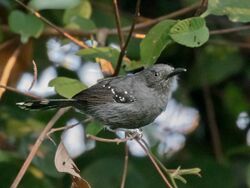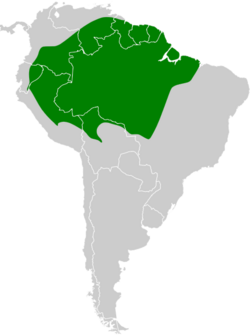Biology:Grey antbird
| Grey antbird | |
|---|---|

| |
| Male | |
| Scientific classification | |
| Domain: | Eukaryota |
| Kingdom: | Animalia |
| Phylum: | Chordata |
| Class: | Aves |
| Order: | Passeriformes |
| Family: | Thamnophilidae |
| Genus: | Cercomacra |
| Species: | C. cinerascens
|
| Binomial name | |
| Cercomacra cinerascens (Sclater, PL, 1857)
| |

| |
The grey antbird (Cercomacra cinerascens) is a species of bird in the antbird family Thamnophilidae. It is found in Bolivia, Brazil , Colombia, Ecuador, French Guiana, Guyana, Peru, Suriname, and Venezuela. Its natural habitat is subtropical or tropical moist lowland forests.
The grey antbird is 14.5 cm (5.7 in) in length. The male is grey with a darker grey tail. It has white spotting on the wing coverts and broad white spots near the tips of the tail feathers. The female is olive brown above, pale ochre brown below and has a darker brown tail. The white spotting on the wings and on the tail of the female is similar to that on the male.[2]
Taxonomy
The grey antbird was described by the English zoologist Philip Sclater in 1857 from a specimen obtained near the Rio Napo in Ecuador. He coined the binomial name Formicivora cinerascens.[3][4] The specific epithet is Late Latin meaning "ashen".[5] This antbird is now placed in the genus Cercomacra that was introduced by Sclater in 1858.[6][7]
Four subspecies are recognised:[7]
- C. c. cinerascens (Sclater, PL, 1857) – southeast Colombia and south Venezuela to east Ecuador, northeast Peru and northwest Amazonian Brazil
- C. c. immaculata Chubb, C, 1918 – east Venezuela, the Guianas and northeast Brazil
- C. c. sclateri Hellmayr, 1905 – east Peru, northwest Bolivia and southwest Amazonian Brazil
- C. c. iterata Zimmer, JT, 1932 – southeast Amazonian Brazil and northeast Bolivia
References
- ↑ BirdLife International (2018). "Cercomacra cinerascens". IUCN Red List of Threatened Species 2018: e.T22701662A130215349. doi:10.2305/IUCN.UK.2018-2.RLTS.T22701662A130215349.en. https://www.iucnredlist.org/species/22701662/130215349. Retrieved 13 November 2021.
- ↑ Ridgely, Robert S.; Tudor, Guy (2009). Birds of South America: Passerines. Helm Field Guides. London: Christopher Helm. p. 355, Plate 28.1. ISBN 978-1-408-11342-4.
- ↑ Sclater, Philip L. (1857). "Descriptions of twelve new or little known species of the South American family Formicariidae". Proceedings of the Zoological Society of London 25: 129–133 [131–132]. doi:10.1111/j.1096-3642.1857.tb01217.x. https://biodiversitylibrary.org/page/12861177.
- ↑ Peters, James Lee, ed (1951). Check-List of Birds of the World. 7. Cambridge, Massachusetts: Museum of Comparative Zoology. pp. 213–214. https://www.biodiversitylibrary.org/page/14480550.
- ↑ Jobling, James A. (2010). The Helm Dictionary of Scientific Bird Names. London: Christopher Helm. p. 107. ISBN 978-1-4081-2501-4.
- ↑ Sclater, Philip Lutley (1858). "Synopsis of the American Ant-birds (Formicariidae). Part II containing the Formicivorinae or Ant-wrens". Proceedings of the Zoological Society of London Part 26: 232–254 [244]. https://biodiversitylibrary.org/page/32271768.
- ↑ 7.0 7.1 Gill, Frank; Donsker, David; Rasmussen, Pamela, eds (January 2021). "Antbirds". IOC World Bird List Version 11.1. International Ornithologists' Union. https://www.worldbirdnames.org/bow/antbirds/. Retrieved 6 July 2021.
External links
Wikidata ☰ Q859634 entry
 |


